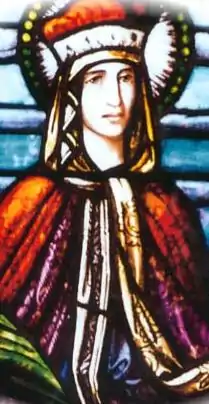Ludmila of Bohemia
Saint Ludmila (c. 860 – 15 September 921) is a Czech saint and martyr venerated by the Orthodox and the Roman Catholics. She was born in Mělník[1] as the daughter of the Sorbian prince Slavibor.[2] Saint Ludmila was the grandmother of Saint Wenceslaus,[1] who is widely referred to as Good King Wenceslaus. Saint Ludmila was canonized shortly after her death. As part of the process of canonization, in 925, Wenceslaus moved her remains to the St. George's Basilica, Prague.
Saint Ludmila | |
|---|---|
 Saint Ludmila | |
| Martyr | |
| Born | c. 860 Mělník |
| Died | 15 September 921 Tetín castle (cs), Tetín, Bohemia |
| Venerated in | Eastern Orthodox Church, Roman Catholic Church |
| Canonized | shortly after her death |
| Major shrine | Chapel of St. Ludmila |
| Feast | September 18 |
| Attributes | veil |
| Patronage | Bohemia |
Marriage
Ludmila was married to Bořivoj I of Bohemia, the first Christian Duke of Bohemia,[1] in 873. The couple was converted to Christianity through the efforts of Saint Methodius.[1][3] Their efforts to convert Bohemia to Christianity were initially not well received,[1] and they were driven from their country for a time by the pagans. Eventually the couple returned, and ruled for several years before retiring to Tetín, near Beroun.
The couple was succeeded by their son Spytihněv. Spytihněv was succeeded by his brother Vratislav. When Vratislav died in 921, his son Wenceslas became the next ruler of Bohemia.[3] It had been mainly Ludmila who raised her grandson and she now acted as regent for him.
Ludmila and Drahomíra

Wenceslaus' mother Drahomíra became jealous of Ludmila's influence over Wenceslaus. She had two noblemen Tunna and Gommon (probably of Frankish or Varangian descent) murder Ludmila at Tetín, and part of Ludmila's story says that she was strangled[1] with her veil. Initially, Saint Ludmila was buried at St. Michael's at Tetín.[4]
Saint Ludmila was canonized shortly after her death. As part of the process of canonization, in 925, Wenceslaus moved her remains to the St. George's Basilica, Prague.[3] She is venerated as a patroness of Bohemia. She is considered to be a patron saint of Bohemia, converts, Czech Republic, duchesses, problems with in-laws, and widows. Her feast day is celebrated on September 16th.
Antonín Dvořák composed his oratorio Svatá Ludmila (Saint Ludmila) between September 1885 and May 1886. The work was commissioned by the publisher Littleton for the Leeds Festival.[5]
See also
- St. George's Basilica, Prague
- House of Přemysl
- Bohemia
- Statue of Saint Ludmila, Charles Bridge
- Saint Ludmila, patron saint archive
References
| Wikimedia Commons has media related to Saint Ludmila. |
- The Editors of Encyclopaedia Britannica (September 11, 2018). "Saint Ludmila Slavic saint". Encyclopaedia Britannica. Encyclopædia Britannica, inc.
- Překlad Josef Vajs, 1929
- Ott, Michael. "St. Ludmilla." The Catholic Encyclopedia. Vol. 9. New York: Robert Appleton Company, 1910. 24 Feb.2013
- Kantor, M., The Origins of Christianity in Bohemia, 1990
- Halstead, Susan. "St. Ludmila, patroness of Bohemia", British Library, 16 September 2013
Sources
- Pekar, J., Die Wenzels- und Ludmilla-Legenden und die Echtheit Christians (Prag, 1906).
- Christianus Monachus, "Vita et Passio sancti Venceslai et sanctae Ludmilae avae eius," in Magnae Moraviae Fontes Historici (Brno, 1967), 186-199.
- Ingham, N. W., "The Lost Church Slavonic Life of Saint Ludmila," in Studia Slavica Mediaevalia et Himanistica. Riccardo Piccio dicata. T. 1-2 (Roma, 1986), 349-360.
| Royal titles | ||
|---|---|---|
| Preceded by - |
Duchess consort of Bohemia c. 874–888/891 |
Succeeded by Drahomíra |